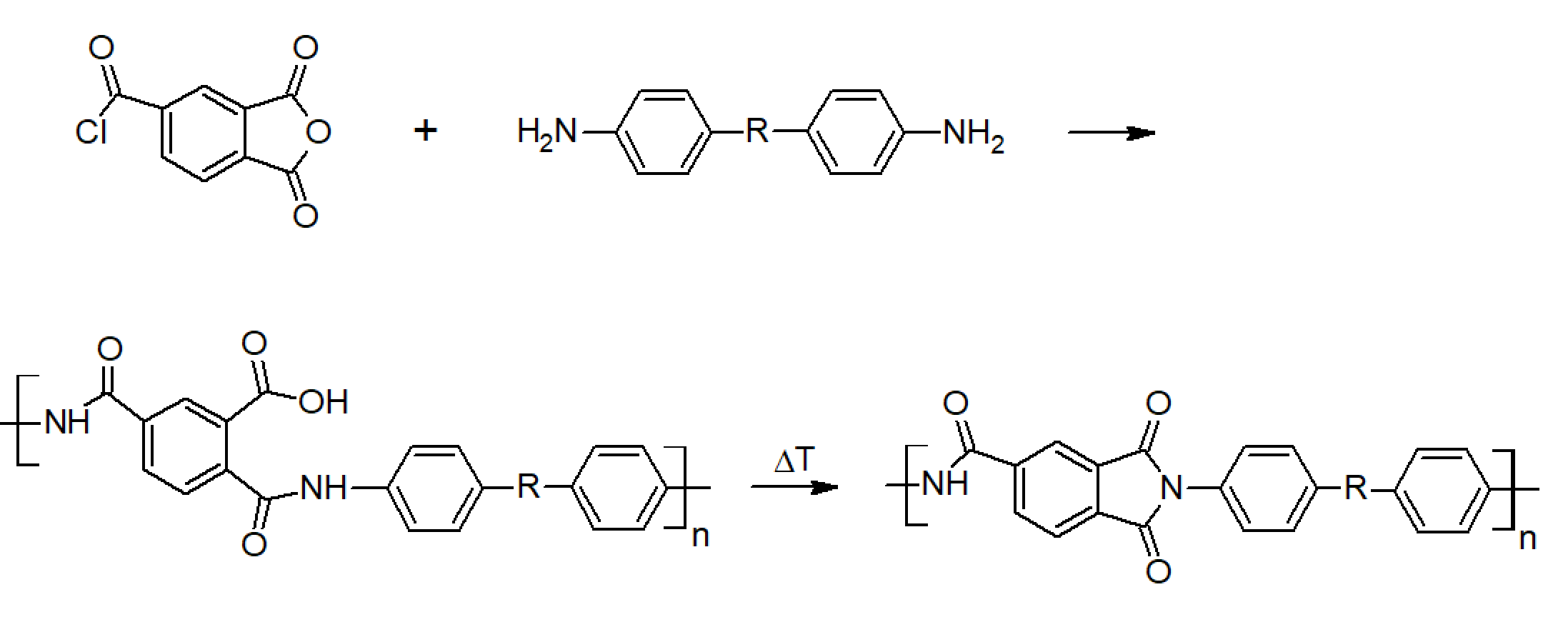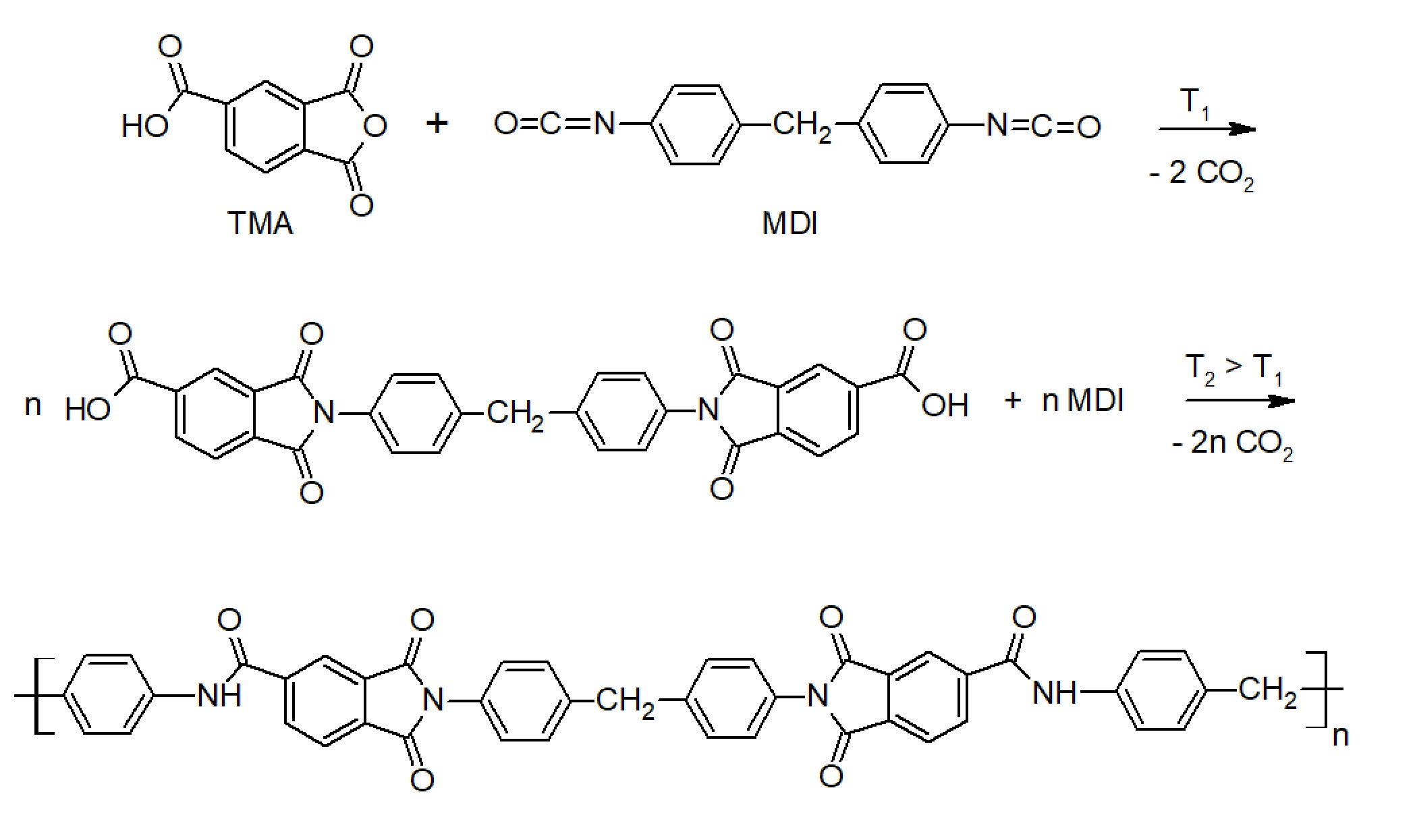Polyamideimide (PAI)
Properties
Polyamideimides (PAIs) are high performance amorphous engineering thermoplastics of yellow to brown color. They have outstanding thermal, mechanical, and chemical properties and are often the best choice for demanding applications where very high mechanical strength, stiffness and low friction in combination with high temperature, corrosion, and wear resistance is required.1 Compared to typical polyimides, PAIs have a lower continuous service temperature but a higher fracture toughness. For example, some grades maintain their strength and stiffness up to 500°F (260°C) whereas some poly(ether)imides can be operated up to 700°F (370°C). Like PIs, PAIs resist most chemicals and can be operated in harsh thermal and chemical environments even under severe stress with little to no creep, wear, and chemical degradation. They are virtually unaffected by aliphatic and aromatic hydrocarbons as well as chlorinated and fluorinated solvents. Some grades also resist concentrated acids (30%) including hydrochloric, phosphoric, and sulfuric acid but are attacked by hydrofluoric acid and strong bases such as sodium hydroxide.2 In many cases, they can replace metals and other high performance materials in structural applications.3
Other important performance properties include:
- High tensile and flexural strength over a wide temperature range up to + 225°C (450°F)
- Excellent resistance to wear and creep under load (bearing grades)
- Extremely low coefficient of thermal expansion
- Excellent heat resistance in air (250°C)
- High glass transition temperature of about 275°C2
- Excellent dimensional stability up to 250°C
- Difficult to burn with very little smoke
- Outstanding resistance to degradation by UV radiation
- Good chemical resistance to many acids, alcohols, automotive fuels and oils, and halogenated solvents
- Good electrical properties (not as good as fluorocarbons)
- Good processability (can be extruded, thermoformed, injection and compression molded)
However, polyamideimides have also some limitations and shortcomings. For example, they are rather expensive and often require a post-cure to achieve their full potential especially maximum wear and chemical resistance. They also cannot be used above their glass transition temperature unless cross-linked.
SYNTHESIS
Polyamideimides are either prepared from an aromatic diamine and aromatic acid chloride anhydride (acid chloride route) or from an aromatic diisocyanate and anhydride (diisocyante route). A common reaction is the addition of a trimellitic acid anhydride (TMAC) to a methylene diamine usually at ambient or elevated temperatures (20 - 60°C) in a dipolar aprotic solvent, such as dimethyl sulfoxide (DMSO), N-methyl-2-pyrrolidone (NMP) or N,N-dimethylacetamide (DMAc). The second step is the conversion of the amic acid groups to the cyclic imides at elevated temperatures (post-cure).

High molecular weight polyimides have also been prepared by the reaction of a diisocyanate such as 4,4'-methylenediphenyl diisocyanate (MDI) with an acid anhydride such as trimellitic anhydride (TMA). This process is a two step reaction. The first step is the addition of an anhydride to a diisocyanate with subsequent decarbonation reaction at elevated temperatures which leads to an acid terminated imide. This reaction is also carried out in an aprotic solvent. The second step is the reaction of the residual isocyanate groups with the acid functionalities at elevated temperature:

A large variety of polyamideimides can be prepared from a large number of monomers. Even subtle variations in the structure of the dianhydride and diamine will have a significant effect on the properties of the final polyamideimide. Chain stiffness and chain-chain interactions are undoubtedly the most important factors, which depend on the ratio and arrangement of flexible and rigid groups and on the presence of bulky side groups.
The most common polyimides are synthesized from trimellitic anhydride and MDI.
A major drawback of the methods above is the unavoidable presence of solvent and the formation of carbon dioxide during the condensation reaction. Both the condensation products and the solvent need to be fully removed prior post-processing of the resin to achieve high performance properties.
COMMERCIAL Polyamideimides
Polyamideimide (PEI) was first developed and marketed by Amoco to improve the processability of imides by introducing amide bonds. Today, these resins are manufactured by Toyobo, Quadrant (Mitsubishi) and Solvay under the trade names Vylomax, Duratron, and Torlon. The resins are available in unfilled, glass- and carbon- fiber filled grades. The unfilled grades have the highest impact resistance (toughness) wheras the filled grades (30%) have higher modulus, strength, and lower creep. The carbon fiber reinforced grades have the best fatigue properties and retention of stiffness at elevated temperatures. Some grades also contain small amounts of PTFE to further improve the wear resistance for more demanding applications.
Applications
Polyamidemides are often an excellent choice for demanding applications
where high mechanical strength, and low creep, fatigue and wear
combined with outstanding chemical properties are required. Typical applications include molded or machined parts
for the automotive and aerospace industry such as non-lubricating bearings, seals, bushings, pistons, gears,
and thrust washers.
PEI is also widely used in magnet wire enamels for
heavy duty motors and in high-performance, non-stick, and corrosion resistant coatings for various other
demanding industrial uses.
Because of their high price, polyamideimides are usually only used when outstanding properties are required.
The typical maximum service temperature in air is about 260°C.
THERMO-PHYSICAL PROPERTIES
References and Notes
1According to Solvay, Torlon PAI has the highest strength and stiffness of any thermoplastic up to 500°F (260°C).
2Source: Solvay, Torlon PAI Design Guide
3Torlon's specific strenght is higher than that of steel2